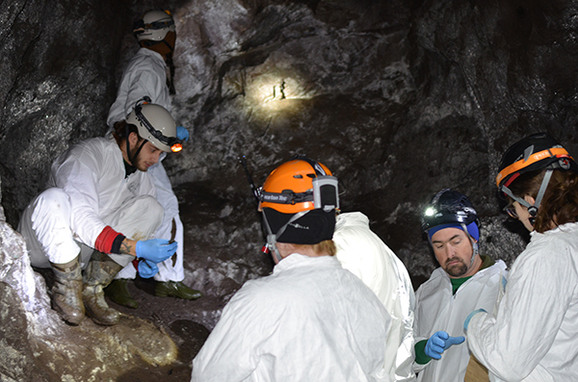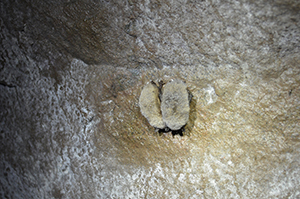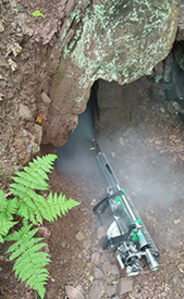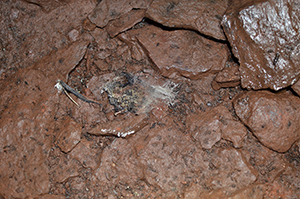 Saving Michigan’s bats
By HANNAH SCHAUER
Michigan Department of Natural Resources
 Maybe you’ve noticed fewer bats active during those warm, buggy summer evenings and wondered why?
This situation is not unique to Michigan. In fact, many places throughout North America have seen declines in bat numbers.
The reason for the reduction in numbers for many species of bats is a fungus named Pseudogymnoascus destructans – responsible for a disease called white-nose syndrome that is killing bats in parts of America and Canada.
Many insect-eating bats survive winter by going into hibernation, during which they lower their body temperature and fat deposits accumulated during autumn months are used to sustain them.
|
Places where bats hibernate, such as caves or underground mines (known as hibernacula), are ideal environments for this fungus, as it thrives in cold, damp conditions.
The fungus disrupts hibernation, causing bats to prematurely and repeatedly awaken, quickly depleting their fat reserves and diminishing their body condition.
“Bats weakened by the loss of fat reserves are unable to replenish themselves due to lack of insects to eat in winter and die before spring,” said Dan O’Brien, veterinarian at the Michigan Department of Natural Resources’ Wildlife Disease Laboratory. “Infected bats often exhibit abnormal behavior such as flying during daylight hours or gathering outside of caves in cold weather.”
 The disease is called white-nose syndrome because of a white, powdery appearance on exposed skin, like the muzzle and wings, of affected bats.
White-nose syndrome was first documented during the winter of 2006-2007 in New York. It was confirmed in Michigan in early 2014.
Transmission of the fungus associated with white-nose syndrome primarily occurs through bat-to-bat contact but can also be transmitted by humans visiting infected caves and mines without decontaminating their shoes and equipment.
While there is no evidence that white-nose syndrome is infectious to humans, the loss of large numbers of bats may have an indirect impact on people.
Check out five bat myths dispelled.
Bats are a primary predator of nighttime insects, and large-scale losses of bats may lead to an increase in insect populations, some of which cause crop damage or spread diseases.
|
View the interactive white-nose syndrome occurrence map to see its current distribution in North America.
Efforts to help Michigan’s bats
“The DNR has been on the leading edge of bat conservation and research for a long time,” Bill Scullon, DNR Wildlife Division field operations supervisor, said. “Working with partners and researchers is as critical as ever in the battle to save our bat species from white-nose syndrome.”
One such effort is the gating of entrances to important bat hibernacula to minimize human disturbance to hibernating bats. Custom steel structures are designed and put up to ensure public safety while allowing the bats to come and go freely from the hibernacula.
“These gates have been built on both public and private lands,” said DNR wildlife biologist John DePue. “Some of these gated sites house large populations of bats in the winter and are important locations to protect.”
 Michigan is also one of the few states that participates in field trials of potential treatments to combat white-nose syndrome.
Researchers and students from Western Michigan and Ball State universities, working with the DNR, have been applying an organic compound – derived from shellfish, called chitosan – to bats and the inside of hibernacula. This chitosan compound appears to help bats combat the effects of white-nose syndrome.
Additionally, in some of Michigan’s hibernacula, University of California, Santa Cruz researchers have been treating sites with chlorine dioxide. Treatment is applied to the site when bats are not present to reduce the number of spores that cause white-nose syndrome.
“Chlorine dioxide is used to kill all the fungal spores throughout a mine during the summer, before bats return for the winter,” said DePue. “This will disinfect the site and reduce infection rates and mortality rates.”
DNR staffers, along with researchers from Eastern Michigan University, also conduct annual bat monitoring. Hibernation sites are visited during the winter to learn about places where bats are experiencing higher survival rates, and to monitor population trends.
Status of bats in Michigan
Nine species of bats are found in Michigan.
Little brown and big brown bats are the species most often seen by people. Silver-haired, red and hoary bats are also found in Michigan.
|
The tri-colored bat (or eastern pipistrelle) is a species of special concern in Michigan and the evening bat is listed as a threatened species.
Indiana bats have been under the protection of the federal Endangered Species Act since 1967. The northern long-eared bat was added to the List of Threatened and Endangered Species as a threatened species in recent years.
“Due to the severity of the decline in population from white-nose syndrome, the northern long-eared bat was listed as a threatened species by U.S. Fish and Wildlife Service in April of 2015,” said Dan Kennedy, DNR endangered species coordinator.
Dr. Allen Kurta, a professor of biology at Eastern Michigan University, said recent surveys of hibernacula in Michigan indicate an 83 percent decline in bats at those survey sites, compared to data from surveys conducted before white-nose syndrome’s arrival.
“The data indicate a 77-percent decline in little brown bats, a 93-percent fall in eastern pipistrelles, and a 96-percent decrease in northern long-eared bats,” Kurta said. “It is getting very difficult to find a northern long-eared bat anywhere in the state.”
 Although these numbers are dire, not all bats seem to be as heavily impacted by white-nose syndrome.
In addition to caves and mines, some bats may use man-made structures, like buildings, as hibernacula. These places may not provide appropriate conditions for the growth of the white-nose syndrome fungus, allowing for higher bat survival rates.
“Big brown bats and silver-haired bats do not seem to be experiencing major declines,” Kurta said.
For now, we will continue to see fewer bats dotting the night’s sky in Michigan, but the DNR and its partners are working hard to ensure those numbers increase and that bats will not be eliminated from the landscape.
How to help bats
Installing bat houses can be helpful for bats. Various factors are important when putting up a bat house, including location, color and height. Bat houses should not be in areas frequented by people or domestic animals. To learn tips and tricks for bat houses, check out Bat Conservation International’s website, filled with bat house resources.
Maintaining bat habitat is another way to help bats. Some bats like to roost in trees that have loose bark. Maintaining these types of trees can provide additional roosting locations. Many bats prefer forested areas near a water source, as these places are often abundant with insects.
|
Those exploring caves or mines should be sure to abide by closures and follow decontamination guidelines to reduce the spread of white-nose syndrome. Avoid visiting these locations during the winter months when bats may be hibernating.
Other ways to help bats:
- Minimize the use of insecticides as these can impact a variety of animal species, including bats.
- Do not attempt to help injured bats. Because of concerns for disease transmission, rehabilitation of bats is illegal in Michigan.
- Donate to the DNR’s Nongame Fish and Wildlife Fund and talk to others about how to help bats.
- Celebrate bats during Bat Week 24 – 31, 2018.
Learn more about Michigan’s bats by visiting michigan.gov/bats.
Check out previous Showcasing the DNR stories in our archive at michigan.gov/dnrstories. To subscribe to upcoming Showcasing articles, sign up for free email delivery at michigan.gov/dnr.
/Note to editors: Contact: John Pepin, Showcasing the DNR series editor, at 906-226-1352. Accompanying photos and a text-only version are available below for download and media use. Suggested captions follow. Credit: Michigan Department of Natural Resources, unless otherwise noted.
Text-only version of this story.
Bands: Wing bands shown on a little brown bat in Ontonagon County.
Brown: These little brown bats are hibernating in an Ontonagon County mine shaft.
Dioxide: Sites are treated with chlorine dioxide when bats are not present.
Gate: A gate at the Mead Mine within Porcupine Mountains Wilderness State Park allows bats to come and go freely from their hibernacula.
Gear: The White-nose Syndrome National Response Team outlines ways to decontaminate your gear.
Hero: Be a bat hero during Bat Week. Learn more at batweek.org.
Monitoring: Steve Smith, foreground, and Al Kurta, of Eastern Michigan University, conducting annual bat monitoring.
Red: Red bats are one of the nine species of bats found in Michigan.
Remains: The remains of a bat infected with white-nose syndrome found in an abandoned mine in the Upper Peninsula.
Team: A team of bat researchers working in an Ontonagon County mine shaft.
Treatment: Researchers work to apply chitosan treatment outside of a mine shaft in Ontonagon County.
Sidebar photo: “Understanding Bats” illustration./
|